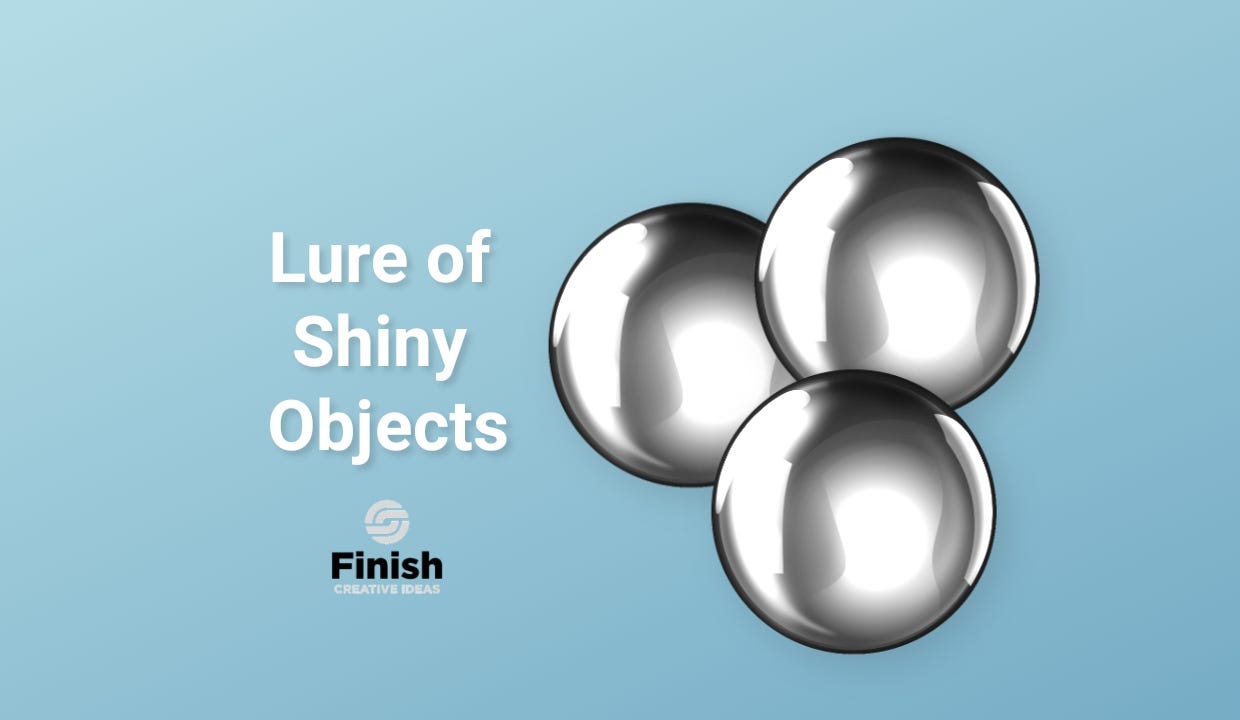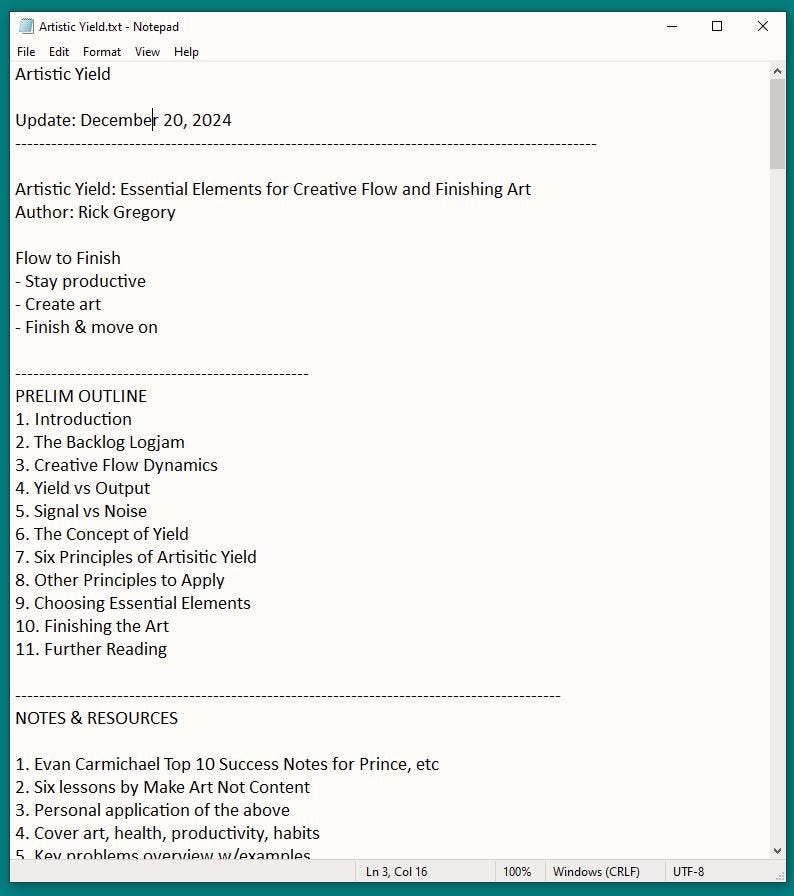Hey Creatives!
Why is it that we start projects with so much excitement, only to watch them fizzle out halfway through?
Raising my hand as a culprit here.
Planning, tweaking, thinking: all of these are productive action right?
In truth, resistance throws out roadblocks everywhere. It’s rarely a straight line drive down the superhighway when tackling a creative endeavor.
It’s more like an obstacle course with hurdles, puddles and detours.
After days or weeks of suspect productivity, self-doubt creeps in, kills momentum and starts the downward spiral to inefficiency or even a crash landing.
For me, there is a trigger word in the back of my subconsciousness … linger.
Once I reach that state of mind, I am in trouble.
Chasing shiny objects feeds into this malaise and prevents work from getting done. Distractions are ubiquitous and it’s impossible to avoid them all. So its best to know what to expect and learn a few techniques to ward them off.
Nothing is worse then being trapped in the Project Spin Cycle. Unfinished ideas wear done your creative resolve and missed opportunities defeat your progress.
Today, the focus is on finishing creative ideas to the endpoint. There are three key steps to discuss:
avoiding distractions
valuing project completion
maintaining consistency
Shiny objects are like sirens calling you into the sea to crash and burn on the rocks.
Let’s avoid the false illusions of productivity and increase your true earning potential.
Identifying Shiny Objects: A Simple Checklist
Self-awareness is the mechanism. Recognizing patterns is the process.
Getting off the track to nowhere is the goal.
Here is a rundown of common problems associated with “shiny object syndrome,” so that you begin to notice when you’re on the edge of procrastination and project stagnation.
Mindless Project Hopping: Are you constantly jumping from one project to another without completing any? Check your hard drive.
New Ideas Over Old Ones: Do you frequently drop existing projects for new ones, believing the latest idea is more exciting or promising? Also referred to as Idea Hopping.
Lack of Long-Term Interest: Are your new pursuits often driven by short-term excitement rather than long-term potential or alignment with your goals?
Avoidance Behavior: Ask yourself if pursuing a new idea is actually a way to avoid challenges in your current project. Finishing requires boldness.
Decision Fatigue and Dopamine Rushes: Be aware that the initial thrill of starting something new can lead to decision fatigue later on, making it harder to stick with what matters most.
ACTION STEP: Take 5 minutes to reflect on your current projects. Ask yourself: Is this aligned with my short or long term goals? Do I really want to dive into this topic? If no, then set aside the idea or dump it.
Use these signals to identify when a "shiny object" is derailing your focus and make conscious choices about where to allocate your time and energy.
Step 1. Focus Filters: How to Avoid Distractions and Stay on Track
Filters allow the good stuff to flow and take out the toxins.
This is the key lesson to learn, whether in life-crunching situations or just on a simple creative project. Filters reframe and reset your priorities. They help define and evaluate your own ideas against your personal goals.
What do you do? Ask questions.
Am I making real progress, or just keeping busy?
Have I started something new before finishing what I’m working on?
Is this project still aligned with my goals?
Do I spend too much time and money on courses to learn, rather than do?
When your focus is scattered, you end up with a pile of half-finished projects that don’t contribute to your portfolio, income, or creative growth. Recognizing these patterns early is key to regaining control.
My creative barrier is having too many ideas to complete. It drives me crazy.
New courses from respected mentors is a major problem too. All of their proven digital programs entice my creative buttons. Sometimes your personal toolkit is empty and oftentimes it is full of unused tools.
It is handy to decide on the minimum toolset required to finish projects. And then repeat the tasks for the next project.
ACTION STEP: Write down your top three current projects. Next time a new idea strikes, ask yourself if it supports these projects or distracts from them. Take just one minute to jot down the idea in a separate notebook.
Step 2. The Power of Completion: Why Finishing Matters More Than Starting
Here is the introduction to the Rolling Stones’ song “Start Me Up:”
If you start me up If you start me up, I'll never stop If you start me up If you start me up, I'll never stop
I love rock ‘n’ roll, but this is a blatant lie. How I wish it were true. Unfortunately, creatives are not that efficient. We stop for all kinds of reasons.
In an odd bit of wordplay, starting is just a start. It matters far less than finishing.
Completion is the end goal. Momentum gets you there. And credibility builds up your profile along the journey. Ironically, closing the file on a project, opens the door of opportunity on the other side.
Finishing creative ideas serves as an elixir. It soothes your creative anxiety and reinforces your creative chops to the world.
Ideas are just the kindling to light the fire of completion.
And fire is dangerous, not only in the moment, but also in a lifetime of creative works.
ACTION STEP: Choose one unfinished project and commit to dedicating enough time each day towards its completion. When you hit the publish button, take a few moments to internally record your thoughts. Then remember.
Step 3. Consistency Hacks: How Small Steps Lead to Big Wins
How do you eat an elephant? One bite at a time.
Sorry to use an old cliche, but it does set the right tone of consistency.
The start to finish process is fraught with pitfalls. Your brain recalls every psychological trick to screw you up. And the demon called “Resistance” tries to trip up your progress at every step along the way.
It is a battle between obstacles and outcomes. Think Stoic philosophy.
The “elephant in the room” is your new project. The tiny bites to get it done result from breaking up tasks into small steps to build momentum and avoid overthinking about the big thing in front of you.
Chew, chew, chew.
Regular progress maintains motivation each day. Choose your own goals, whether daily, weekly or not at all. Do whatever it takes to come back the next day and work.
Songwriting does not fit the regular “writing” mode. It requires perseverance and repetition. Songs come and go and come and go again. They don’t follow an order.
Despite the hardships, songwriters stick with a melody, a verse line or a song title until they can paste together a song-like version. Then, they come back again and start ripping up the song structure until it flows like honey into a hit song.
ACTION STEP: Break down any large task into several smaller tasks that take the load off a completing a project. Keep track of your efforts to recognize and recall which methods provide the best results. Then repeat the process and nail down your own protocols.
Benefits of Finishing Projects
Sometimes the obvious is not so obvious, so let’s cover the benefits of finishing projects that should be apparent to any creator.
1. Learning and Growth
Learn as you go. That’s the way forward.
But it’s not the accumulation of knowledge and skills that matters, these are just the prerequisites. It’s the fundamental action taken day after day to implement any program or project goal.
Consistency wins out over gold-star capabilities. Personal growth includes trial and error, falling and failing and reassessing your talents and tactics.
2. Reliability and Trust
Unfinished creative works are promises unfulfilled.
Without completion, this promise breaks two bonds. The first is to yourself and your creative idea. The second is to your audience or end-users, those who believe your works are solid.
Your reputation does not have to be spotless, but it must be productive enough to gain the trust of potential consumers or admirers. This is not even a traditional sense of reliability. It is built in the ether of the internet, where relationships can be quirky.
But if nothing is forthcoming from your side, then a simple click can sever the connection.
3. Increased Productivity and Efficiency
The finishing habit is a skill to develop and practice.
Shiny objects are cruel. They often come when you are at your weakest point. Near the end of a project.
Productivity requires patterns and repetition. You don’t want to be a robot, but you sure can gain insights from their behavior. Creative projects usually follow an arc. It’s up to you to identify and recognize what makes you click into gear and what throws you off track.
Reliance on online productivity tools is often a crutch. I prefer to utilize the simplest methods that work for my personal rhythm.
For Example:
I use Notepad.txt files for every project. It’s easy to access for quick thoughts and changes. It doesn’t require logging into the cloud. Editing is just cut and paste. And the lack of features or options makes for focused work.
4. Personal Satisfaction (So Sweet!)
Hitting the upload button and publishing a project sets off both relief and elation.
Nothing satisfies a solopreneur like completing a creative idea to a finished and viable project. It is the culmination of thought, effort, execution and belief all rolled up in one simple action.
Even the accolades and cash payments from others don’t really measure up to those moments when you prove yourself to yourself. Of course, financial rewards sweeten the deal.
Accomplishments are internal. Achievements are external.
Do it for yourself first. And if recognition flows afterwards, then use it for motivation to carry on.
By focusing on these benefits, creatives can see their own value in consistently completing their work—both personally fulfilling and professionally advantageous.
Chase Dreams, Not Objects
I am a pragmatic dreamer.
That means I chase dreams, but I realize that it ain’t easy. I’ve bought my share of shiny objects that turned into years of hard work and little gain. I came away with two things: marketing lessons and personal resolve.
For my age, my internet marketing knowledge is high.
For myself, I resolved to figure out the puzzle to find my niche and place in cyberspace.
Today, I know where I am. I don’t get distracted by shiny objects anymore.
I still value knowledge and buy courses that fit inside my personal toolkit.
But I am done with all the noise and distractions of the past. I have enough to finish creative ideas and enjoy the satisfaction of putting my best efforts on the table.
My dreams are on the horizon. And I am nearly there.
Until next week,
— Rick
Comments & Takeaways
As Finish Creative Ideas gets started on its digital journey, it would be helpful to receive some input from our readers:
Please leave comments on the current articles presented
Suggest ideas on what needs to be covered in the future
Let us know your personal takeaways and perspectives
And any post re-stacks on Substack or sharing on social media is very much appreciated.
Now go be creative.




